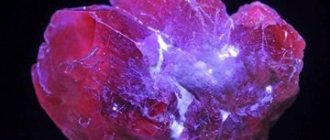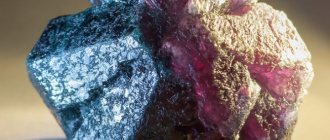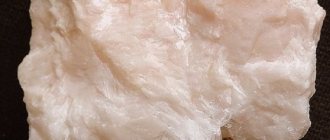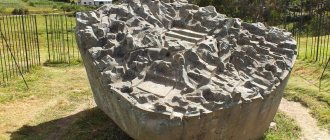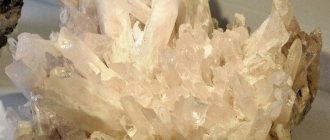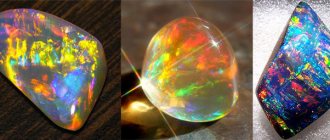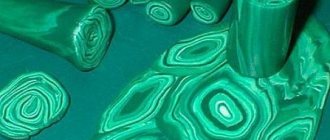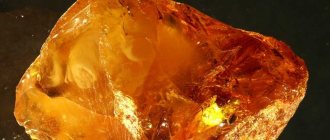Perelivet is a little-known stone that is not popular even in its homeland, Russia. In the West, no one knows about him at all. This is explained by the fact that the only source is located in the Urals; mining there has not been carried out for a long time. The deposit was depleted during the Soviet Union. The discovered gems began to be used to pave roads. As a result, almost nothing remained of the large deposits. But in terms of external characteristics, overflow is not inferior to agate; they are often confused.
For a long time, the mineral was called Ural agate, considering it a new variety of an already known rock. And only in 1985, scientists proved that the overflow has a different composition and belongs to the quartz group!
Story
The mineral was discovered at the end of the 18th century by the courtier of Catherine II, Alexander Razderishin.
This happened in the Middle Urals, near the village of Shaitanki. The deposit gave the stone its name - Shaitan overflow.
The Empress favored Russian ore exploration, tried herself as a master stone cutter, and made large orders to the Yekaterinburg lapidary factory.
The peak of popularity of overflowing occurred during the reign of Empress Catherine II.
For the nobility, they made things that adorned life: powder boxes, bonbonnieres, snuff boxes, boxes, table cutlery.
In the Urals, gems were actually lying underfoot; they could be found on a plowed field or a washed-out river bank.
Shaitan overflow
After Catherine there were no connoisseurs. The Soviet government also did not understand the significance of the stone: mega-reserves of deposits became the “asphalt” of large highways, as a result of which they were quickly depleted.
Today, interest in the gem is being revived.
Place of Birth
There is only one developed overflow deposit - the village of Oktyabrskoye, Sverdlovsk Region (formerly the village of Shaitanka). The first serious examination of the mining site was carried out in 1932 by Soviet mineralogist G.N. Vertushkov.
The primary deposit - quartz-overflow veins - was discovered in 1960. Since 1970, prospecting and evaluation work has been carried out, and already in 1971, the Uralquartzsamotsvety enterprise was mining the mineral from six veins discovered at the deposit. Surface mining of overflow blocks has been carried out at the mines since 1799.
Today, the only place of gem deposits is conserved; industrial mining of the stone is not carried out. The reason is considered to be depletion of reserves - immediately after the opening, several roads were paved with overflow, exhausting kilometer-long reserves. Small deposits were also spoiled and forgotten.
However, interest in the unique gem is being revived. This is facilitated by collectors, as well as amateur miners who continue to search for the mineral near the abandoned deposit site. It is also known that the gem is found in Transbaikalia, as well as on the lands of Kazakhstan and Bulgaria.
Description
Externally, the overflow looks like agate. Even academician A.E. Fersman considered it a variety of this stone.
However, this is not overflowing agate, but a layered alternation of quartz, quartzine and dickite:
- Overflow is an opaque (sometimes translucent) variety of Ural quartz, in which colored layers (up to 7-8 mm thick) gently flow and flow.
- The colors of Ural stone range from white-bluish to sunny (yellowish, orange, red). The yellow-orange color scheme is associated with the Madagascar iridescence, mined on the island of the same name.
- A polished gem acquires a silky shine and iridescence.
The local version of the name is perelevt.
Shaitanskiy perelivt – native Ural minke whale
View all products from Shaitansky overflow>>>
A long time ago, when the mountains on earth flowed like water, in one place magma poured onto the surface and froze. Volcanoes exploded on the earth, the sea was agitated, then the jungle grew and huge dinosaurs roamed, then people appeared, and in the frozen magma, which turned into granite, its own quiet life flowed. When earthquakes occurred, this life took a new turn. And so, three hundred million years later, the Great Ruler sent a man to this place. He was supposed to find and send her rare and beautiful stones. One day this man was walking and saw a block of stone, nothing special. But he hit it with a hammer, the block split, and inside the block there were beautiful intricate patterns of stripes. The stripes shimmered like silk and glittered in the sun. The stone was sent to the ruler, and she ordered several objects to be made from it for herself, and she even carved some things herself, because she considered this stone to be precious. And I was not mistaken. From the dossier:
The Shaitan overflow
is a complex accretion of alternating layers of fine-crystalline quartz, quartz and the clay mineral dickite.
Other names: overlift, Ural agate, overflow agate. The discoverer of the Shaitan overflow is considered to be court councilor (lieutenant colonel) A.V. Razderishin, who was the head of the Commission for finding stones and other rarities.
This was in the 18th century, when Russia, under the leadership of Catherine II, was actively exploring the Ural Mountains, and mineralogical expeditions were often marked by remarkable finds. The place where Razderishin found beautiful stones with a wavy pattern was and is still located near the village of Shaitanki in the Middle Urals, where Tatar migrants lived. The head of the Commission was a great lover of minerals and described the find in the catalog of his collection: “Droplet chalcedony, with a green, white and red surface, having a shiny surface in some places, was discovered by me two miles from Shaitanka in 1797 on the very surface of the earth.” Here Alexander Vasilyevich mentions the primary deposit, and he found the placer itself in 1791. However, it is known that back in 1787, Yakov Fedorov’s party extracted eighteen pounds of overflow near Shaitanka. The stone turned out to be very similar to agate and was considered as such until 1985, until the structure of this “agate” was studied by Leningrad scientists. The main role in such a long misconception was played by the opinion of Academician A.E. Fersman, who attributed the overflow to chalcedony agates. After that, it simply never occurred to anyone to take a closer look at the stone. The old name of the overflow has still been preserved - “Ural agate.” The word “overflow” itself comes from the verb “to overflow”; it perfectly defines the appearance of this beautiful and unique stone. Its layers seem to shimmer with a silky sheen, smoothly transitioning into warm yellow, milky white and brick-red shades as soft as in a watercolor painting. In addition to the Shaitan stone itself, there are other stones - Zotovsky, Makarovsky - found in different places in the Urals, there are deposits in Transbaikalia, even in Kazakhstan, but nowhere else in the world is there such a stone as the Ural stone. Different names simply distinguish gems from different deposits, but their general structure is the same. An overflow is a multi-grained quartz aggregate with a zonal structure; zones differ in the size or shape of quartz grains. The patterns themselves arose when underground hot hydrothermal solutions flowed through cracks in the earth's crust and were deposited on their walls. The overflowing Shaitansky mine was discovered in 1799, where overflow was found close to the surface in the form of blocks of various sizes. The primary deposit itself was explored in 1960. It is interesting that with depth the color of the iridescence changes and becomes less vibrant, the shades “cooler”, approaching blue, gray and bluish the closer to the surface, the more the iridescence acquires warm, smoky yellowish, pinkish, red-orange and red tones. This occurs due to exposure to the external environment, especially ultraviolet radiation from the sun. Thus, what destroys many other valuable minerals turns out to only benefit the overflow, which diligently absorbs the sun in order to delight us with its warmth. In the old days, there were two harvests in the Urals: one, like everyone else, in the fall, and the other - semi-precious - in the spring. The fact is that the frozen arable land during the winter pushed stone blocks to the surface and the minerals “ripened” by spring: defective crystals were destroyed, amethysts lost their smokiness, and a purple hue appeared, so beloved by the clergy, and the Shaitan shimmer acquired honey shades. It turned out that every spring the earth produced a new harvest of stones, which continued to be collected in the fall. And the peasants were engaged in cutting gems in the winter, when seasonal work ended and the long cold days began. At the Yekaterinburg lapidary factory, tabletops were made from Shaitan overflow, fireplaces were lined with it, stones with the most interesting designs were used to make gems, cameos, small sculptures, as well as caskets, ashtrays, powder compacts, writing utensils, etc. The gems “Diana holding a deer by the horns” and “Apollo Navinsky in full height, naked, leaning on the table” were cut out of the Shaitan overflow. After the discovery of the overflow, a tabletop was made for the Winter Palace in St. Petersburg, and the Pavlovsk Palace Museum houses an ashtray framed in silver, inlaid with garnets - an indication that the Ural overflow was considered a very valuable stone. The Hermitage houses gems from overflow, the author of which was Empress Catherine II herself, who was fond of agate carving. This is how the Shaitan overflow became known in the capital, and that is why the gem from a small deposit gained such fame. It must also be said that the overflow has proven itself well in work: it is perfectly polished and has a rich range of shades; if handled skillfully, it is not inferior in beauty to other agates. W. F. B. Brickman wrote about this back in 1779 in “Essay on Precious Stones” (translated by Vasily Bespalov). He noted that there are agates that “are in no way inferior to the oriental ones in their pleasantness and hardness,” and the translator adds in a footnote: “If our Ekaterinoburg agates, or so-called overflows, were mined and processed by skilled people, then of course there would be no foreign they were not inferior in pleasantness and appearance: it is true that they are rather quartz-like, but it seems to me that they were even more pleasant in themselves.” Apparently, Bespalov was one of the first to notice the difference in the structure of the overflow from ordinary agates. In the modern stone-cutting industry, overcasting is used not only for small plastics and mosaic paintings, but also for the production of beads, cabochons, and inserts into rings, pendants, earrings and brooches. One of its remarkable features, if not the most remarkable, is that it is not paintable, unlike agate. There are many beautiful African agates on the Russian market, painted in bright, unnatural colors. When buying a shaitan shimmer, you can be sure that this is its natural color, the way nature created it, with the warmth of the bright sun. Wonderful products are created in the famous Yekaterinburg workshop of V. Vasiliev. The small figurine of the Jumping Firefly in a sundress made of iridescent color seems to be alive: the master skillfully captured the movement of the folds of the sundress, which are conveyed by the reddish waves of the semi-precious pattern. The firefly dances in the dying fire, and around her there are flashes of burgundy rhodonite and coal-crystals of pyrope. Very beautiful varieties of overflow were found in the Madzharovskoye deposit in Bulgaria. They are close to the Shaitan shimmer in color, but in Modzhar’s it is sometimes even more original and more contrasting. The pattern is obtained from the thinnest, less than a millimeter, slightly wavy stripes of pinkish, yellowish, lilac, white flowers and wider stripes of light lilac quartz, separated by a milky-white continuous strip of chalcedony. The iridescent patterns are original, with a pattern reminiscent of openwork lace made from stripes with scallops of the same pleasant gentle tones, but emphasized by opaque orange and brown stripes. The width of the stripes reaches two and a half centimeters. Sometimes the strips contain cavities lined with crystals of transparent colorless quartz. With all this, Madzhar's iridescence is characterized by the fact that some stripes are more translucent than others, and the wider they are, the stronger the degree of translucency, even to the point of transparency. Only chalcedony milky stripes and dark red areas remain opaque. Depending on the width and shape of the stripes, as well as on the ratio of brightly and lightly colored stripes, decorative varieties of iridescence can be distinguished. The most common are straight- or slightly wavy-fine-striped and comb varieties. In 1975-1978, prospecting and assessment work at the Shaitanskoye deposit was carried out by the Isetskaya party of the Ural-QuartzSamotsvety production association, which discovered additional agate-bearing quartz veins. Currently, the deposit continues to be studied, and one can think that the popularity of the Shaitan overflow will only grow. Overflow has always been considered a symbol of physical strength, beauty and health. The owner of the overflow does not have a shortage of property, and he and his words are pleasant to people, since prudence does not leave him. According to legend, the owner of this stone can drink as much wine as he wants - his mind will remain clear. In folk medicine, it is believed that those who wear this stone are not susceptible to leprosy, epilepsy, scabies, and other similar diseases. Overflow agate is also used when joints hurt: the stone is heated and placed on the sore spot. Overflow has no zodiac preferences; it can be worn by people of any zodiac sign. Its complex structure, pleasant color transitions, layering characteristic of agates and at the same time strong quartziness, high hardness make up the special appearance and character of the Shaitan iridescence is precious for its uniqueness, and although it is considered an ornamental stone, it can also amaze in jewelry, as a The poet Vitaly Gaev said this: Central Urals agates are the native shaitan shimmer... But the honey-golden color in the craft will surprise the stone with its shimmer and sparkle, and will bestow it with quiet sadness. View all products from Shaitansky overflow>>>
Physico-chemical characteristics
For a chemist, the overflow mineral is quartz with an elementary basic formula. Graininess, zonal structure, intricate surface pattern are the merit of nickel, copper, and iron compounds in its composition. Plus sunlight and hydrothermal origin.
| Rock type | Igneous rock |
| Color | milky white, sometimes yellowish, smoky or greenish with picturesquely distributed light brown, and in places reddish stains and spots |
| Texture | 2 flat brecciated |
| origin of name | got its name from the iridescence of color from the old Russian synonym for chalcedony - perelift |
Varieties and colors
Iridescence is characterized by a variety of colors. This gem combines many shades that smoothly transform into each other. The stone is:
- smoky yellow;
- red-orange;
- brown-red;
- pink;
- milky white;
- gray;
- blue;
- bluish.
Cold shades of the mineral are characteristic of samples located in the bowels of the earth. Nature gives stones on the surface warm, honey-orange, brighter shades. This is due to exposure to ultraviolet radiation, absorbing which the overflow only becomes prettier.
Interesting fact: Madzharovsky overflow is identified as a separate variety, samples of which were found on the territory of Bulgaria, in the Madzharovsky deposit. The color of these stones is brighter and more contrasting than that of the Shaitan specimens, and the width of the stripes reaches 2.5 centimeters. A characteristic feature of the Madzhar stone is the zonal division of millimeter white, yellow, pink lilac wavy stripes and wide light lilac stripes, separated from each other by a strip of milky chalcedony.
Also read: Carnelian - the meaning of the stone for a person
The wider the stripes, the more light they transmit, sometimes translucent to complete transparency. There are specimens with openwork stripes of delicate tones, emphasized by a brown or orange stripe or lines created by small crystals of colorless transparent quartz.
In addition to color differences, the mineral is classified according to decorative features - the shape and width of the stripes, as well as the ratio of alternating light and bright lines. Decorative overflow can be:
- straight-thin striped;
- wavy-thin-striped;
- comb;
- concentric (rare).
The first two types are the most common.
Where is the stone used?
The decorative effect and physical properties of the overflow determined the scope of its application.
Jewelry
There is no serial production of jewelry; it is made only by hand-made craftsmen. They create products of all kinds. The most expensive frame is silver.
Ring with overflow
Decor
Durability and good polishability have made the gem a favorite of stone cutters:
- The Hermitage houses a gem carved by Empress Catherine II.
- Among the historical masterpieces are a tabletop for the royal Winter Palace and a silver ashtray inlaid with garnets from the Pavlovsk palace and museum complex.
- The products of modern craftsmen are also utilitarian: small plastic items, candelabra, photo frames, boxes.
There are also large examples: mantelpieces, tabletops, panel decor.
Areas of application
Overflow has all the characteristics that are so valued by craftsmen. This stone is hard and lends itself well to processing and polishing. You can create any thing from the mineral - a gem, a box, a cameo, an ashtray, a table top, a figurine. Cabochon-treated stones look great in jewelry - beads, brooches, earrings.
Jewelry with stone
Important! A distinctive physical feature of overflow from agate is the lack of porosity. This makes it impossible to artificially change color, which is applicable to agates - the mineral does not absorb a single drop of pigment.
Brooch
Since industrial stone mining has ceased, amateur craftsmen are engaged in searching for and processing stones. Therefore, it is impossible to find a product or jewelry made of gems on store shelves. One of the famous places where overcast products are created is the workshop of V. Vasiliev in Yekaterinburg. For the needs of lithotherapy, objects necessary for massage sessions are created from the shaitan nugget.
How to spot a fake
Stone is rarely counterfeited: it is tedious and financially unprofitable.
It is easy to distinguish plastic or glass by the following characteristics:
- the mineral surface pattern is chaotic-smooth, with soft transitions from color to color;
- shades are not loud;
- silky shine.
Stones are sold in large stores, where sellers indicate the deposit.
Interesting Facts
The first finds of the gem date back to 1787. Together with A.V. Razderishin participated in the discovery of a new mineral, Yakov Fedorov.
The first enterprises involved in the extraction, processing, and production of products from overcast were the Yekaterinburg and Peterhof cutting factories. Among the large number of gems, boxes, cameos, powder compacts and other works by various masters, the outstanding products are the tabletop of the Winter Palace, as well as an iridescent ashtray in a silver frame, complemented by garnets - the property of the Pavlovsk Palace Museum.
The village of Cheremiska is located not far from the mothballed overflow deposit. The beautiful house of the former village head, built two centuries ago, serves as a local history museum. There is a large collection of overflows stored there - a delight for the eyes of any connoisseur of rare minerals.
Magic properties
From time immemorial, only sorcerers, magicians, and esotericists worked with overflow:
- Peering into the magic crystal, they read the past and future.
- Cultists, considering stones to be conductors of divine fire, used it in rituals.
- According to esotericists, overflow is a “flash drive” that accumulates signals sent to Earth by the Higher Power.
However, experts warn: this is a stone of illusions. A ball made of it can show what is desired, not what is real. Therefore, it is better not to test the magical properties of the overflow, but simply wear it as a talisman.
Magic is more useful on an intellectual level:
- the person will become smarter;
- his memory will be strengthened;
- he will become a speaker;
- will be able to think creatively.
The gem embodies physical and mental health, adds charisma and attractiveness.
Like amethyst, overflowing protects against intoxication.
The owner of the talisman is always listened to, his financial well-being is indestructible.


